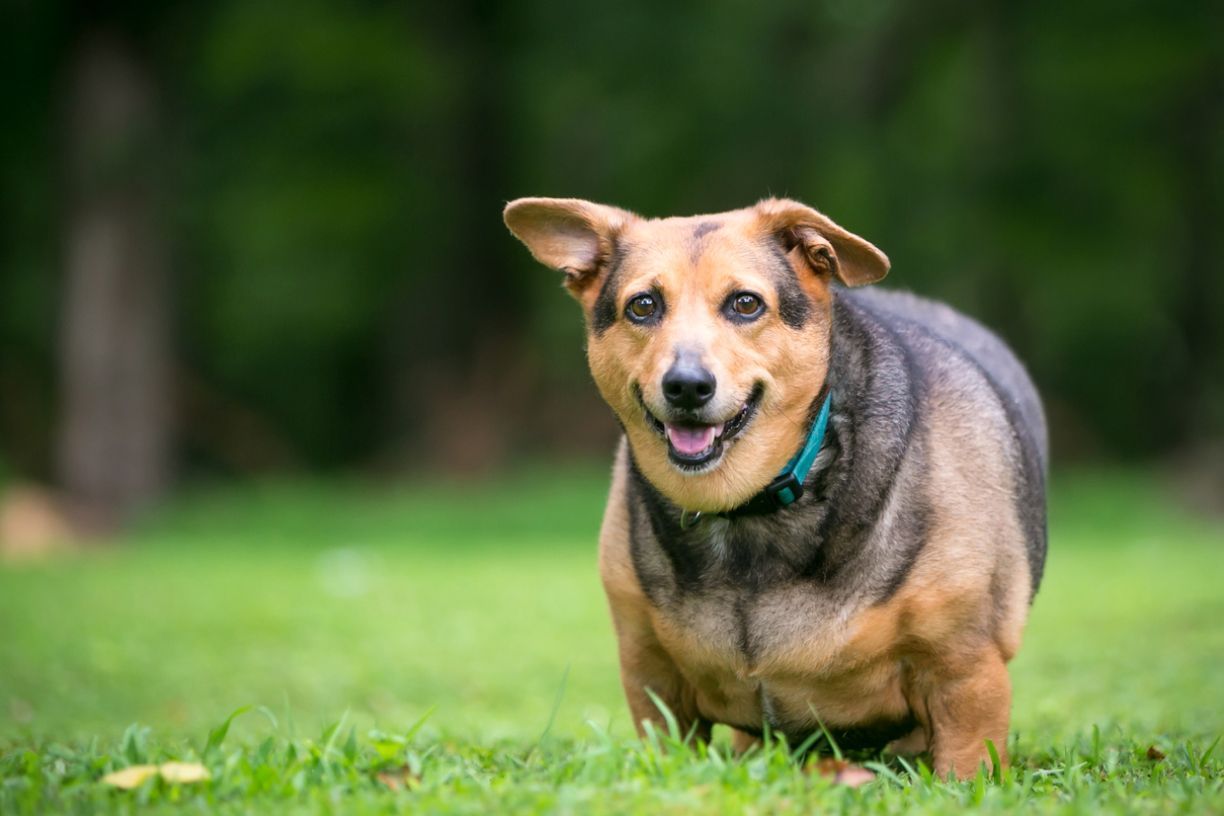How to prevent and manage obesity in dogs

Obesity in pet dogs has been labeled an epidemic around the world. An overweight dog has a much higher risk of developing serious medical issues and complications, and many pet owners do not realize that their dog is overweight. Read on to learn:
- What is canine obesity?
- What are the health risks of obesity in dogs?
- Can I help my dog lose weight?
- Is my dog overweight?
Pet obesity is an extremely common health condition that affects a dog’s physical health, quality of life, and overall lifespan. In addition, the resulting health conditions can lead to higher veterinary bills compared to dogs of a healthy weight. However, obesity can be treated and prevented with the help of a veterinarian. Understanding obesity and the risk of obesity to your canine companion is the first step.
What is obesity in dogs?
Obesity is an inflammatory disease in which a dog’s body weight is at least 20% higher than the ideal weight for its age and breed. However, a dog is overweight when their body weight is higher than their ideal body weight at a much lower percentage. Weight gain is caused when calories consumed through food intake exceed the number of calories burned through exercise. Obesity and being overweight are the most common health conditions in dogs in the United States and Canada, affecting more than half of pet dogs. The problem isn’t going away, in fact it is growing. Left untreated, pet obesity can lead to a long list of serious health risks.
What are the risk factors and health issues for overweight and obese dogs?
An increase in body weight over a dog’s healthy range puts extra strain on the body’s joints and internal organs. Obese animals are more at risk of premature death and suffer from many medical and chronic diseases, including:
- Joint diseases, such as osteoarthritis, CCL injuries, and intervertebral joint disease
- Diabetes mellitus
- Heart disease
- Respiratory disease
- Kidney disease
- Liver disease
- Pancreatitis
- Skin disease and disorders
- Urinary conditions
- Tumors and cancer
- Intolerance to hot weather
- Shorter life expectancy
In addition, dogs that are overweight have lower exercise tolerance, making it even more difficult for them to lose weight and live a healthy life. A dog doesn’t have to be obese to be at risk of these conditions, either. Being even slightly overweight raises the chances of health risks.
What dogs are the most likely to be overweight?
Obesity and being overweight are caused by ingestion of too many calories versus how many calories are burned through daily exercise. However, there are some other underlying factors to becoming overweight or obesity in dogs, such as:
- Specific breeds, such as labs and flat-coated retrievers
- Females of any age
- Spayed and neutered dogs
- Sedentary lifestyle, lack of exercise, or low activity levels
- Some endocrine disorders, such as diabetes mellitus, hypothyroidism, and Cushing’s disease
- Some medications, such as steroids and antiepileptics
“Portion control is crucial for weight management in dogs,” explains Dr. Matt Spiegle, a Vetster veterinarian. “Feeding excess food, treats, and table scraps without accounting for the extra calories promotes weight gain.”
Dogs that have disorders, such as diabetes mellitus, hypothyroidism, and hyperadrenocorticism, and are on specific medications are more likely to gain weight due to fluctuations in metabolism. If your dog has trouble losing weight, experiences unexplained weight gain, or has these conditions, it’s best to talk to a veterinarian about what you can do to help manage their weight.
How can I prevent obesity in my dog?
The best way to prevent the health conditions associated with obesity is to prevent your dog from becoming overweight in the first place. Consult with a veterinarian on the right food and caloric intake for your dog’s individual needs. Every dog is different! If your dog is still growing, it is helpful to monitor their weight using a vet-approved growth chart. Once the daily calorie requirements have been calculated for your dog, stick to them. Keep in mind any additional calories from treats and table scraps, especially calorically dense treats such as peanut butter, and adjust your dog’s food as necessary. Continue to exercise your dog daily and make sure treats make up no more than 10% of your dog’s daily calories.
A great way to keep your dog from eating their food too quickly at mealtime is to make them work for their meals. Surprisingly, dogs are contrafreeloaders, meaning they prefer food they have to work for. That’s why they love food toys so much! Try feeding your dog in a puzzle toy or snuffle mat if they eat dry food, or try a sensory lick mat for wet food. It will keep mealtime interesting, help your dog exert more energy during mealtime, and make them slow down when eating.
How can I help my dog lose weight?
To help your dog lose weight, start discussing the issue with a vet and create a weight loss plan. Overweight and obese animals need decreased calories and increased regular exercise, but each individual dog benefits best from a plan that fits their personality, likes and dislikes, age, breed, and any underlying health conditions they may have. You can help your dog lose weight by:
- Calculating the caloric intake needs of your dog with the help of a vet
- Accurately measuring food portions with a measuring cup or food scale
- Providing a balanced and complete diet targeted for weight loss
- Controlling all food your dog receives, including treats
- Staying informed about the caloric density of all foods offered, including treats
- Making treats less than 10% of overall diet
- Increasing physical activity through walks and playtime
- Making mealtimes into a “payment” your dog needs to “earn,” which appeals to their contra-freeloader instincts
- Offering play and affection instead of extra food when your dog begs
- Avoiding table scraps, extra treats, and calorically dense foods
- Providing smaller, more frequent meals
- Providing plenty of fresh, clean water
- Separating pets during dinnertime and picking up leftover food
Pet owners should weigh their dogs regularly and keep track of their body condition scores. This will help keep track of their successful weight loss journey and reduce the risk of obesity. In addition, calculating your dog’s caloric needs will help with portion control. Portion suggestions on dog food labels are broad and may not work for your dog’s individual needs. For homes with more than one pet, feed your animals separately, pick up any leftovers right away, and keep cat food and other pet food out of your dog’s reach. This will not only help your dog lose excess weight but also keep them at a healthy weight for much longer as well. Foods high in fat and low in fiber can also contribute to weight gain in dogs.
Once your dog has reached their target weight, a maintenance diet is necessary for successful long-term weight management. A vet may recommend that your dog stays on weight loss food. Roughly 50% of dogs who lose excess weight will rebound and regain the weight they lost, so continued weight management is essential. A Vetster veterinarian can work with you remotely to calculate your dog’s caloric needs.
What is the ideal weight for dogs?
The exact ideal weight is different for every dog. You wouldn’t want your chihuahua’s weight to match a golden retriever’s ideal weight. An extra pound of body weight will affect a small breed much more than a larger breed, as that pound will be a much larger percentage of their ideal body weight. Specific breeds have healthy weight ranges and your individual dog’s ideal weight will vary depending on their overall size. Studies have shown that smaller breeds are more likely to be overweight but are also more successful in losing and keeping excess weight off.
How do I know if my dog is overweight?
Body condition scores are the best way to determine if your dog is overweight, even if your dog falls in the normal weight range for their breed. A dog’s spine and ribs should be easily felt when palpated and should not be covered by a large amount of fat or, alternatively, protrude too much. Their waist and belly should be tucked when viewed from the side and from above.
Dogs can be overweight or obese without showing other symptoms. If you are unsure if your dog is overweight or if you would like to discuss your dog’s weight loss journey, you can make an online virtual care appointment with a veterinarian on Vetster.
FAQ - How to prevent and manage obesity in dogs
What is the fastest way for a dog to lose weight?
Portion control with a weight loss diet, restricting extra treats, and calculating your dog’s needed caloric intake is crucial for successful weight loss. However, you do not want your dog to lose weight too quickly as this can cause other physical health issues and malnutrition. Work with a veterinarian to develop a nutrition plan for your dog.
How do you treat an overweight dog?
Being overweight and obese is caused by an excess of calories ingested through food consumption versus the number of calories burned through exercise and daily activity. To help a dog lose weight, control the intake of calories they consume through portion control, feed them healthy diets created for weight loss, and restrict treats while increasing their daily physical activity and exercise. It is important to schedule ongoing follow up appointments with your veterinarian while your dog is on a weight loss journey to ensure they are losing weight at a healthy rate.
What happens when a dog is obese?
Dogs experiencing obesity have a much higher risk of developing a large number of potentially life-threatening health consequences that will affect their quality of life, shorten their lifespan, and lead to higher vet bills from treating preventable conditions. Conditions such as cancer, diabetes, and kidney, liver, and cardiovascular disease occur more frequently in obese dogs.
Does obesity shorten a dog’s life?
Yes. Obesity is a serious problem in dogs as it can lead to many dangerous illnesses and medical conditions. Keeping your dog at an ideal weight is crucial for a healthier life and increased well-being.




